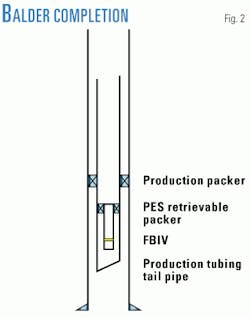Full-bore isolation tool saves N. Sea completion costs
Oil companies in the North Sea have saved operating costs through use of innovative completion equipment such as full-bore isolation valves (FBIVs), placed in the tubing string and used to provide a downhole pressure barrier for suspending wells.
Esso Norway AS's Balder and Norsk Hydro AS's Troll operations provide two examples of such FBIV installations.
FBIVs
OCRE (Scotland) Ltd., Aberdeen, introduced its FBIV in 1995 and says it was one of the first of the nonintervention-type "disappearing plug" barriers. OCRE indicates that its FBIVs have accumulated a 95% success rate and been installed in many regions for both well testing and completion operations.
The FBIV (Fig. 1) is a normally closed disc valve designed to provide isolation within the tubing string, holding pressure from above and below. To operate the FBIV, one cycles it open after a predetermined number of pressure tests to allow full-bore access through the tailpipe. The valve is mechanical and nondestructive, providing a redressible barrier.
OCRE has designed the tools to be run as part of the tubing string, usually below the packer in the tail pipe. Internal tubing pressure operates the FBIV. The pressure is built up and bled off through a pressure cycle acting on the piston area.
In Positions 2-12, the tool cycles through 0-1,100 psi before bleeding back down to 0 psi. This allows for pressure testing before and after setting the packer.
In Position 1, the ratchet moves down towards the fingers that hold the outer sleeve in place. The ratchet unseats the lock ring and the valve, thus freeing the inner mandrel for movement.
Balder
Balder field, off Norway on Blocks 25/10 and 25/11, is 165 km west of Haugesund. Esso developed Balder in 125 m of water with a floating production unit (FPU) and subsea completed wells. It estimates the field will recover about 170 million bbl of oil.
Esso initially intended to drill and complete the wells with a semisubmersible rig during spring and summer 1998. The FPU was to arrive on site towards the end of the well completion period. But delays in the fabrication of the FPU required the wells to be suspended for an extended period.
Esso therefore had to find a suitable long-term barrier.
The traditional method for suspending wells is to run wireline plugs and bring back the rig to remove them. OCRE says that, although technically this is simple, mobilization of a semisubmersible rig or intervention vessel would have added significant costs and time to the project, so Esso chose to run the FBIVs.
It installed the 2.75-in. ID FBIVs just above the reservoir and below PES Ltd.'s retrievable packers in the tubing string (Fig. 2). OCRE says the FBIV is an approved barrier for suspending wells.
OCRE describes the run procedure as involving first testing the FBIV, attached below the packer, on surface with one of the 12 cycles. Then the FBIV is run in the hole on electric line and set with a pyrotechnic setting tool. Prior to suspending the wells to await the FPU, Esso pressure-tested the packer and FBIV to 3,000 psi.
Esso had 13 wells suspended for 12-18 months prior to the FPU hook-up in early October 1999.
To start producing the wells, OCRE says the flowlines were connected and tested against the closed subsurface tree before the tree was opened and the pressure cycling of the tubing string began for opening the FBIV.
Troll
In another example of a FBIV application, Norsk Hydro ran 10 of the valves with sand screens in Troll wells during 1999. In one well, K-22-H, the FBIV was set at 14,500 ft.
OCRE says this type of completion saved Norsk Hydro about $750,000 in rig time during the completion. OCRE describes the placement sequence in the K-22-H well as follows:
- After drilling and casing the well, the rig ran the screens in the drilling mud with an FBIV installed just under the liner packer. This allowed the blowout preventer stack to be pulled and the subsurface tree to be run riserless before starting the well completion stage. The well did not need a workover riser because the well was killed and the FBIV is a certified pressure barrier. OCRE estimates that eliminating a workover riser saved about 5 rig days.
- The rig then ran the 7-in. completion string through the top of the tree inside 103/4-in. casing, followed by stinging the completion string into the seal assembly on top of the liner (Fig. 3).
- Next, the procedure involved circulating lighter fluid into the tubing before landing the tubing in the tree, setting the packer, and tying down the hanger.
- Pressure cycles were applied to the FBIV, which opened it and allowed the well to be ready to produce.



